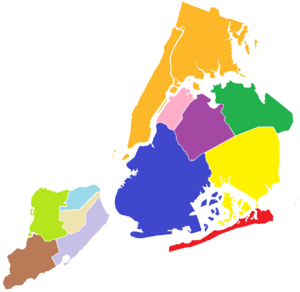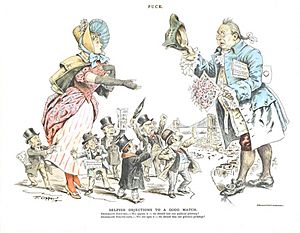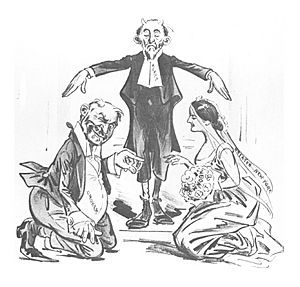City of Greater New York facts for kids

New York County: City of New York Kings County: City of Brooklyn Queens County: City of Long Island City Town of Newtown Town of Flushing Town of Jamaica Town of Hempstead Richmond County: Town of Castleton Town of Middletown Town of Southfield Town of Westfield Town of Northfield
The City of Greater New York was a name used for the much larger New York City that was created on January 1, 1898. This happened when the original City of New York joined together, or consolidated, with Brooklyn, the western part of Queens County, and Staten Island.
Before this big change, parts of the Bronx had already joined New York City. The area west of the Bronx River became part of the city in 1874. The area east of the Bronx River joined in 1895.
In the years leading up to 1898, the City of Brooklyn had also grown a lot. It had added all the other towns and cities in Kings County. However, only the western part of Queens County was included in the big consolidation plan. In 1899, the three eastern towns of Queens County separated to form a new area called Nassau County, New York.
Contents
How New York City Grew
New York City was first started by the Dutch in the 1620s. They called it New Amsterdam, and it was located at the southern tip of Manhattan island. The English later took control and set up different counties in 1683. One of these was the City and County of New York.
By 1691, a law said that New York City included all of Manhattan. Other nearby islands, like what are now Roosevelt Island, Randalls and Wards Islands, and Liberty Island, were part of New York County.
Brooklyn also has a long history. It was first set up by the Dutch in 1646. It became a village in 1814 and then a city in 1834. Over the 1800s, Brooklyn grew by adding surrounding areas. By 1895, it covered all of Kings County. By 1890, Brooklyn was the fourth-largest city in the United States!
People had been talking about combining New York City and its neighbors since the late 1820s. In 1857, the New York State government suggested uniting the region. They wanted to improve the harbor and connect trade systems. But people were worried about such a big project, so the plans didn't happen right away.
The Big Consolidation Plan
The idea of a "Greater New York" was pushed forward by many politicians. A very important person was Andrew Haswell Green. He was known as "The Father of Greater New York." Green was part of the group that managed Central Park, which gave him a good platform to share his ideas.
A special group called the "Greater New-York Commission" led the "Vote for Greater New York" movement. Some people made fun of it, calling it "Andy Green's hobby." But they were wrong! The main goal was to combine New York and Brooklyn. Their fire departments had already joined in 1865. Adding places like Long Island City and other rural areas was meant to help them grow in the future.
Politics played a role too. The Republicans were stronger in Brooklyn, and the Democrats were stronger in New York City. Each party hoped to have more power in the new, bigger city.
To make the consolidation happen, people in all the affected areas had to vote. The people organizing the vote really wanted consolidation to pass. They even put a full-page ad in The New York Times newspaper, telling people to vote "For Consolidation." One argument was that if New York didn't expand, Chicago might soon become the biggest city in the U.S.
Not everyone agreed. Many people in Brooklyn and other areas didn't want to join. They worried about losing control over their local communities. Some Brooklyn newspapers, like the Brooklyn Daily Eagle, argued that joining New York City would change Brooklyn's unique identity. Some politicians who opposed the plan were accused of being dishonest. There were also real concerns about how Brooklyn would get its water and how it would be funded in the future. In the end, these money and water concerns helped convince people, and Brooklyn voted by a small amount to join.
The name City of Greater New York was never an official name. The city's official name remained City of New York in its founding document of 1898 and a later one in 1938. Today, the term "Greater New York" is mostly used when talking about the time when the city expanded.
Each county that joined the city remained a county for state purposes. But within the city, each county also became a borough. The Bronx became the fifth borough, sharing New York County with Manhattan. Later, in 1914, a separate Bronx County was created. This made New York County the same as the Borough of Manhattan.
What Happened After Consolidation
Since the new, larger New York City had most of the population of New York State, it gained a lot of power. Because of this, the state government created some rules to oversee the city. For example, some tax issues and changes in how the city government worked needed state approval.
The New York City Board of Estimate was a group created during consolidation. Each borough had an equal vote in this group. However, the U.S. Supreme Court later ruled in 1989 that this was unfair, as some boroughs had many more people than others but still had the same voting power.
Staten Island's Attempt to Leave
Staten Island is the borough farthest from the others. It's connected by only one bridge, the Verrazzano-Narrows Bridge, and the Staten Island Ferry. In 1993, Staten Island held a special vote to see if its residents wanted to leave New York City and become its own independent city and county.
About 65% of Staten Island residents voted to leave. They wanted a new city charter that would make Staten Island an independent city. However, the plan was stopped by the State Assembly. The movement for Staten Island to leave lost steam when Rudy Giuliani was elected mayor of New York City. He helped meet two of Staten Island's biggest requests: closing the Fresh Kills Landfill in 2001 and making the Staten Island Ferry free in 1997.
Images for kids







